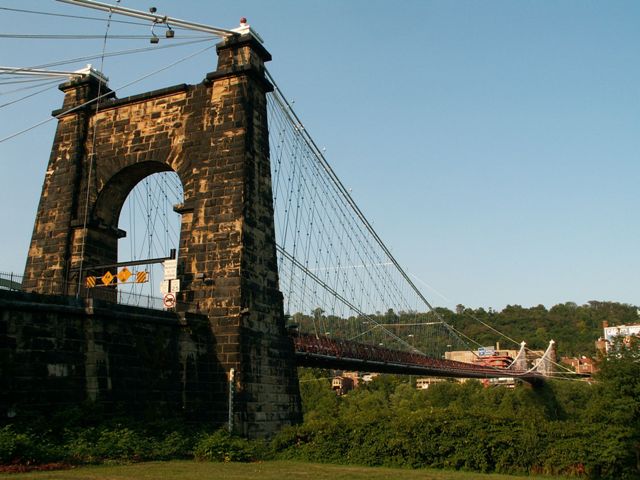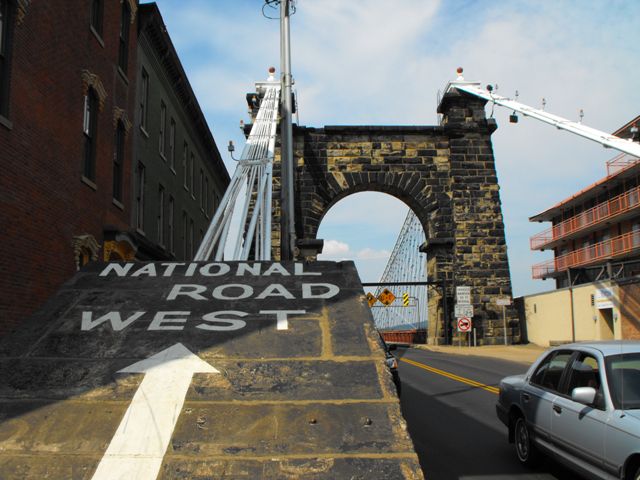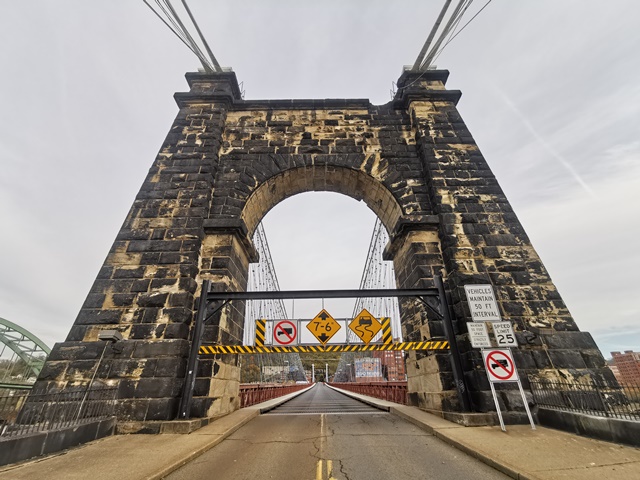We Recommend:
Bach Steel - Experts at historic truss bridge restoration.
BridgeHunter.com Phase 1 is released to the public! - Visit Now
Wheeling Suspension Bridge

Primary Photographer(s): Nathan Holth and Rick McOmber
Bridge Documented: July 4, 2006 - November 4, 2019
Wheeling: Ohio County, West Virginia: United States
1999
949.0 Feet (289.3 Meters)
1,307.0 Feet (398.4 Meters)
20 Feet (6.1 Meters)
1 Main Span(s)
35A090

View Information About HSR Ratings
Bridge Documentation
View Archived National Bridge Inventory Report - Has Additional Details and Evaluation
View Historic American Engineering Record (HAER) Documentation For This Bridge
HAER Drawings, PDF - HAER Data Pages, PDF
View The National Register Nomination Form For This Historic Bridge
Turning The Spotlight From Wheeling's Suspension Bridge For A Moment
This bridge is located in Wheeling, which is noted for its preserved Wheeling Suspension Bridge, that, like wooden covered bridges, is getting all the attention, when some of the attention should be shifted to other historic bridges. The Wheeling Suspension Bridge is a bridge whose historic significance is without compare, and as such it is an important bridge to note. But there is a classic historic bridge discrimination event unfolding in Wheeling. Quite simply, the problem is Georgia Street Bridge, and more importantly the Bridgeport Bridge. While maybe not a pre-Civil War bridge, these stunning metal truss bridges are indeed historically significant for their length as well as their design and age. Each are nationally significant as extremely large and rare examples of pre-1900 bridge construction. In particular, the Bridgeport Bridge has unparalleled design and significance. It is the last remaining landmark-sized bridge known in the United States built by the prolific and important Wrought Iron Bridge Company of Canton, Ohio. This is to say nothing of its beauty, as an ornate mastery of engineering. Its complex geometric beauty formed by its Parker truss configuration, coupled with decorative finials, portals, and railings create a bridge that is a work of art. The Georgia Street Bridge is perhaps not as large and imposing as the Bridgeport Bridge, but as a pin connected Pennsylvania truss also with ornate portal decorations, it is also a remarkable bridge. If these two bridges could be restored and promoted as attractions, it would turn Wheeling into an unparalleled historic bridge destination, and would also allow the town to continue to be a beautiful place for residents. The Wheeling Suspension Bridge is the beginning of a preservation success story for Wheeling, but it should not be the end of the story! The demolition of either or both of Wheeling's two truss bridges would mark a huge loss for the historic bridge community, and would represent a huge loss for Wheeling.
About The Bridge
Much has been written about this national treasure. Both the National Register Nomination Form as well as the Historic American Engineering Record (HAER) Data Pages contain an extensive discussion of the bridge. Dr. Emory Kemp, a noted expert on historic bridges, composed the nomination form, and also provided assistance with the HAER documentation as well. HistoricBridges.org does not intend to restate what has already been recorded, so consult those sources for an excellent history of this bridge. Note that among the HAER drawings is a copy of an original drawing by Charles Ellet, who designed the bridge.
It isn't always apparent to the eye when visiting the bridge, but this bridge runs on a grade. It is interesting that a bridge so old should have a grade to it. Most pre-1900 bridges do not run on a grade. This bridge is one of the few bridges in the entire country to be designated a National Historic Landmark, the highest honor the United States bestows upon historic structures.
This bridge is tagged with the following special condition(s): Unorganized Photos
![]()
Photo Galleries and Videos: Wheeling Suspension Bridge
2006 Documentation
Original / Full Size PhotosA collection of overview and detail photos. This gallery offers photos in the highest available resolution and file size in a touch-friendly popup viewer.
Alternatively, Browse Without Using Viewer
![]()
2009-2010 Documentation
Original / Full Size PhotosAdditional overview and detail photos. This gallery offers photos in the highest available resolution and file size in a touch-friendly popup viewer.
Alternatively, Browse Without Using Viewer
![]()
2006 Documentation
Mobile Optimized PhotosA collection of overview and detail photos. This gallery features data-friendly, fast-loading photos in a touch-friendly popup viewer.
Alternatively, Browse Without Using Viewer
![]()
2009-2010 Documentation
Mobile Optimized PhotosAdditional overview and detail photos. This gallery features data-friendly, fast-loading photos in a touch-friendly popup viewer.
Alternatively, Browse Without Using Viewer
![]()
Rainy Day Visit
Some additional interpretive signage and historical photos are available here as well. This photo gallery contains a combination of Original Size photos and Mobile Optimized photos in a touch-friendly popup viewer.Alternatively, Browse Without Using Viewer
![]()
2019 Additional Unorganized Photos
Original / Full Size PhotosA supplemental collection of photos that are from additional visit(s) to the bridge and have not been organized or captioned. Taken when the bridge was closed to vehicular traffic. This gallery offers photos in the highest available resolution and file size in a touch-friendly popup viewer.
Alternatively, Browse Without Using Viewer
![]()
2019 Additional Unorganized Photos
Mobile Optimized PhotosA supplemental collection of photos that are from additional visit(s) to the bridge and have not been organized or captioned. Taken when the bridge was closed to vehicular traffic. This gallery features data-friendly, fast-loading photos in a touch-friendly popup viewer.
Alternatively, Browse Without Using Viewer
![]()
Eastbound Crossing of the Bridge
Full Motion VideoStreaming video of the bridge. Also includes a higher quality downloadable video for greater clarity or offline viewing.
![]()
Maps and Links: Wheeling Suspension Bridge
Coordinates (Latitude, Longitude):
Search For Additional Bridge Listings:
Bridgehunter.com: View listed bridges within 0.5 miles (0.8 kilometers) of this bridge.
Bridgehunter.com: View listed bridges within 10 miles (16 kilometers) of this bridge.
Additional Maps:
Google Streetview (If Available)
GeoHack (Additional Links and Coordinates)
Apple Maps (Via DuckDuckGo Search)
Apple Maps (Apple devices only)
Android: Open Location In Your Map or GPS App
Flickr Gallery (Find Nearby Photos)
Wikimedia Commons (Find Nearby Photos)
Directions Via Sygic For Android
Directions Via Sygic For iOS and Android Dolphin Browser
USGS National Map (United States Only)
Historical USGS Topo Maps (United States Only)
Historic Aerials (United States Only)
CalTopo Maps (United States Only)






